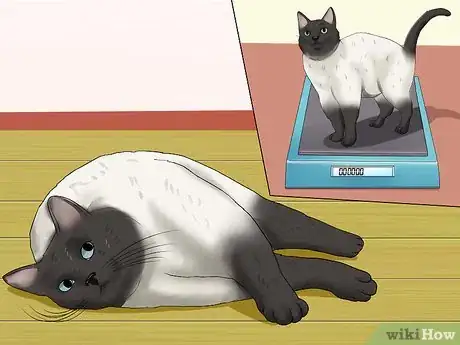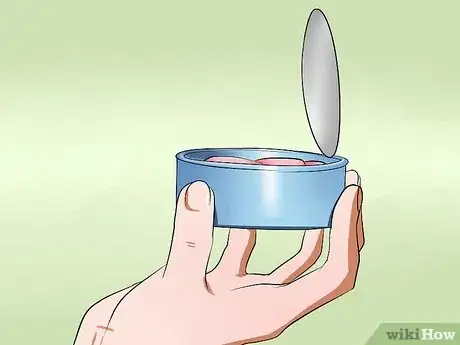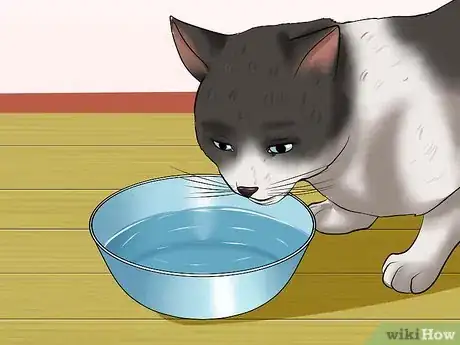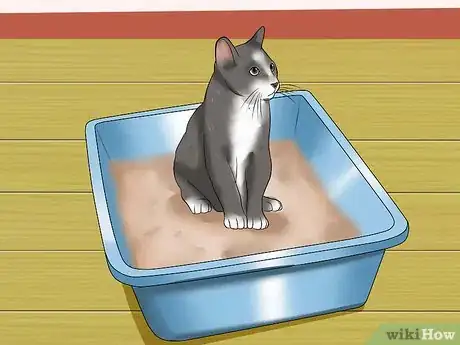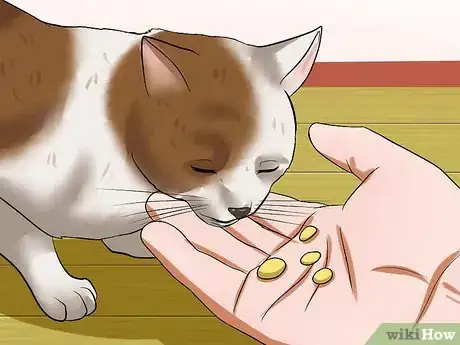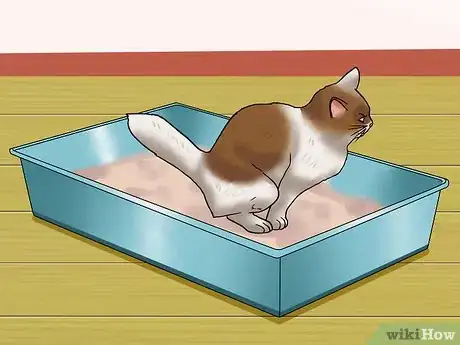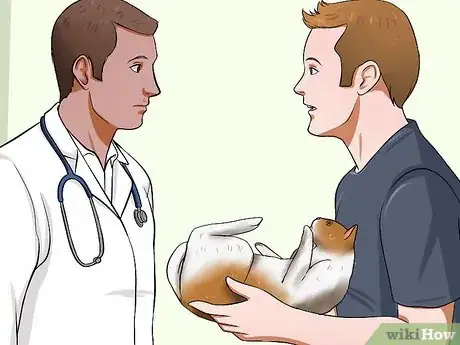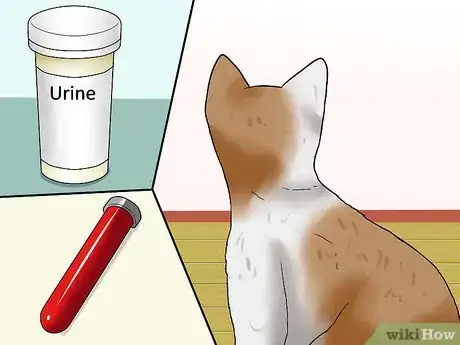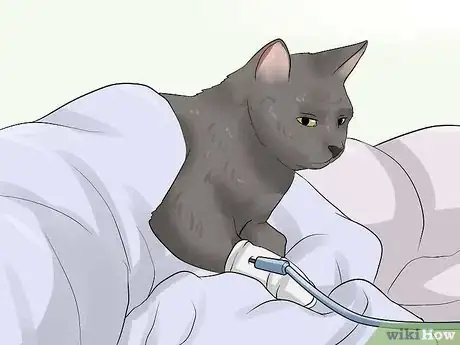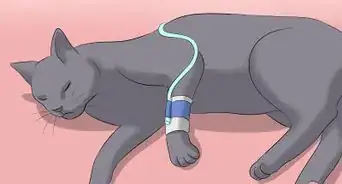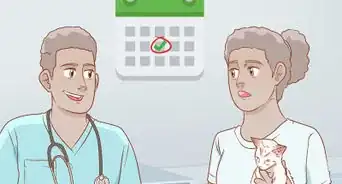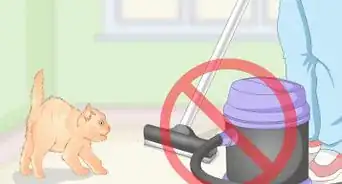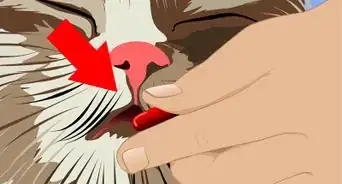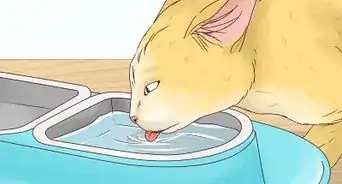This article was co-authored by Natalie Punt, DVM. Dr. Natalie Punt is a Veterinarian and the Founder and CEO of mPet- a smart phone app for pet owners to store, manage and transfer their pets medical records and health information. She specializes in small animal emergency and general medicine and veterinary practice economics. Dr. Punt holds a BS in Biochemistry and Molecular Biology from The University of California, Davis, an MS in Biochemistry from The University at Buffalo, and a DVM from Western University of Health Sciences.
wikiHow marks an article as reader-approved once it receives enough positive feedback. In this case, 100% of readers who voted found the article helpful, earning it our reader-approved status.
This article has been viewed 212,641 times.
Have you noticed your cat in pain or distress during urination? Your cat may be experiencing one of many urinary problems, including urinary tract infections, bladder infections, bladder inflammation, bladder crystals and stones, and bladder cancer. These problems look similar from the outside but have different causes and treatments. Fortunately, there are simple things you can do to reduce the likelihood that your cat develops one of these problems.
Steps
Preventing Urinary Tract Infections in Cats
-
1Keep your cat at a healthy weight. Obese cats tend to have more problems than normal weight cats. Use the Body Condition Scoring system to determine if your cat is a healthy size. These charts rank your cat on a scale of 1 to 9, to determine if your cat is overweight, underweight, or at the ideal weight. The scale considers:
- how easy it is to feel the ribs
- how obvious the waist and abdominal tuck are
- how much excess fat is below the skin
- how much muscle mass is present
-
2Give your cat canned cat food. Canned cat food more closely resembles the natural diet (rodents, birds) of cats and has more protein and moisture than dry food. If your cat is hooked on dry food, consider gradually adding small amounts of canned food and see if you can get your cat to transition to all or mostly all canned diet. If canned food just will not go over with your cat, try offering small amounts of cooked beef or chicken in the form of muscle or organ meat to entice them.
- Do not supplement a commercial diet with medicines that promote urinary acidity. Too much of a “good thing” will cause an imbalance, leading to new problems. Talk to your vet before giving your cat any urinary medications.
Advertisement -
3Be sure your cat always has fresh, clean water. Water is key to a happy urinary tract.[1] Keeping the urine at the proper pH will help prevent crystal and stone formation in the urine. By feeding a balanced diet with plenty of water, the crystals are flushed out of the bladder. This prevents urinary problems.
- Some cats will drink more water if it's flowing, so providing a kitty water fountain may help them consume more water than if it is just in a bowl.[2] If your cat uses a bowl, be sure to clean it regularly.
- Have multiple places for your cat to drink. If you have more than one cat, sometimes dominance over certain food and water dishes is an issue.
-
4Provide enough litter boxes for your cat or cats. The rule is to have 1 more litter box than the number of cats in your home when practical. So if you have 2 cats, you should have 3 litter boxes. [3]
- Check litter boxes frequently and remove waste as soon as you see it. Wash the litter boxes with soap and water every time you change the litter. Do not use bleach, as the residual odor may repel and discourage your cat from using the box.
-
5Minimize stress to your cat. Some cats are just more nervous and worked up than other, more mellow cats. Anxiety does seem to play a part in urinary issues with cats, so try to keep changes in your cat's routine to a minimum.[4] Try to feed her at the same time everyday. Be aware that a change in the weather or a move to a new home could trigger a problem with a cat's urinary tract.
Observing and Treating Urinary Tract Infections in Cats
-
1Watch for symptoms of urinary tract infections in cats. Pay attention to your cat and note if you see any of the following:
- Straining to urinate
- Yowling, or making other sounds, while urinating
- Urinating only small amounts of urine at a time, or none at all
- Frequent trips to the litter box
- Blood in the urine
- Urinating outside the litter box
- Changes in water consumption, often an increase
- Licking the genital area
-
2Know when to take your cat to the veterinarian. Take your cat to the veterinarian immediately if you see blood in your cat's urine or if the cat cannot urinate at all.
-
3Understand the tests your vet may perform. When you take your cat to the veterinarian to diagnose the urinary problem, she will do tests to determine the exact problem and how to treat it. These tests may include:
- a urinalysis to determine pH concentration and the presence of bacteria or crystals
- a urine culture to determine if there is an infection, what kind of bacteria are present, and which antibiotics will kill those bacteria
- blood work to determine kidney health
- x-rays to look for stones in the bladder and the size and shape of the bladder and kidneys
- an ultrasound to look into the bladder for tumors and evaluate the bladder wall (the inside of the kidneys and the ureters)
-
4Realize your cat may need to be hospitalized. Hospitalization may ensure that your cat gets the care and treatment she needs. This might include an intravenous catheter to give the cat fluids, placing a urinary catheter in the urethra to help clear a blockage, or antibiotics to treat a urinary tract infection. Your cat will most likely need to stay in the hospital for a few days.
- Male cats that have experienced one episode of complete or partial urinary blockage are likely to have problems again. If this is the case, you really need to follow your veterinarian’s advice and maintain a proper diet, household regimen and regular medical care.
Expert Q&A
-
QuestionWhy does my cat's UTI keep coming back?
 Natalie Punt, DVMDr. Natalie Punt is a Veterinarian and the Founder and CEO of mPet- a smart phone app for pet owners to store, manage and transfer their pets medical records and health information. She specializes in small animal emergency and general medicine and veterinary practice economics. Dr. Punt holds a BS in Biochemistry and Molecular Biology from The University of California, Davis, an MS in Biochemistry from The University at Buffalo, and a DVM from Western University of Health Sciences.
Natalie Punt, DVMDr. Natalie Punt is a Veterinarian and the Founder and CEO of mPet- a smart phone app for pet owners to store, manage and transfer their pets medical records and health information. She specializes in small animal emergency and general medicine and veterinary practice economics. Dr. Punt holds a BS in Biochemistry and Molecular Biology from The University of California, Davis, an MS in Biochemistry from The University at Buffalo, and a DVM from Western University of Health Sciences.
Veterinarian That can be due to a lot of factors. Make sure your cat is drinking plenty of water, though. A great idea is to provide a faucet or a fountain to encourage the pet to drink it.
That can be due to a lot of factors. Make sure your cat is drinking plenty of water, though. A great idea is to provide a faucet or a fountain to encourage the pet to drink it. -
QuestionHow can I make my cat drink more water?
 Natalie Punt, DVMDr. Natalie Punt is a Veterinarian and the Founder and CEO of mPet- a smart phone app for pet owners to store, manage and transfer their pets medical records and health information. She specializes in small animal emergency and general medicine and veterinary practice economics. Dr. Punt holds a BS in Biochemistry and Molecular Biology from The University of California, Davis, an MS in Biochemistry from The University at Buffalo, and a DVM from Western University of Health Sciences.
Natalie Punt, DVMDr. Natalie Punt is a Veterinarian and the Founder and CEO of mPet- a smart phone app for pet owners to store, manage and transfer their pets medical records and health information. She specializes in small animal emergency and general medicine and veterinary practice economics. Dr. Punt holds a BS in Biochemistry and Molecular Biology from The University of California, Davis, an MS in Biochemistry from The University at Buffalo, and a DVM from Western University of Health Sciences.
Veterinarian Try putting a flavor in the water. I personally like to add tuna in the water, but you can add something else that your cat may find tasty.
Try putting a flavor in the water. I personally like to add tuna in the water, but you can add something else that your cat may find tasty. -
QuestionWe rescued a cat one month ago and now she has dark, rusty urine. Do you think she might have urinary issues we weren't made aware of?
 Pippa Elliott, MRCVSDr. Elliott, BVMS, MRCVS is a veterinarian with over 30 years of experience in veterinary surgery and companion animal practice. She graduated from the University of Glasgow in 1987 with a degree in veterinary medicine and surgery. She has worked at the same animal clinic in her hometown for over 20 years.
Pippa Elliott, MRCVSDr. Elliott, BVMS, MRCVS is a veterinarian with over 30 years of experience in veterinary surgery and companion animal practice. She graduated from the University of Glasgow in 1987 with a degree in veterinary medicine and surgery. She has worked at the same animal clinic in her hometown for over 20 years.
Veterinarian Bloody urine can be caused by many things from stress to a change of diet (causing crystals to be deposited in her urine) or infection. It is unlikely the rescue deliberately misled you and far more likely the cat seemed healthy at the shelter. If you have changed her food, chat to the shelter about what she ate whilst there just in case crystal formation is the cause. Also, look at making the cat's world as safe and reassuring as possible by providing plenty of hiding places, and a calm environment.
Bloody urine can be caused by many things from stress to a change of diet (causing crystals to be deposited in her urine) or infection. It is unlikely the rescue deliberately misled you and far more likely the cat seemed healthy at the shelter. If you have changed her food, chat to the shelter about what she ate whilst there just in case crystal formation is the cause. Also, look at making the cat's world as safe and reassuring as possible by providing plenty of hiding places, and a calm environment.
Warnings
- If you suspect a cat's urinary tract is completely blocked seek immediate veterinary care. Death may result in 24 to 48 hours without urethral catheterization to relieve the blockage or other treatment, including surgery. A cat's urethra could be blocked with mucus, crystals and/or stones.⧼thumbs_response⧽
References
- ↑ Natalie Punt, DVM. Veterinarian. Expert Interview. 14 September 2021.
- ↑ Natalie Punt, DVM. Veterinarian. Expert Interview. 14 September 2021.
- ↑ http://www.catinfo.org/?link=urinarytracthealth
- ↑ Martinez-Ruzafa I, Kruger J, Miller R, Swenson C, Bolin C, Kaneene J. Clinical features and risk factors for development of urinary tract infections in cats. Journal Of Feline Medicine And Surgery [serial online]. October 2012;14(10):729-740.
- ↑ http://www.veterinarypartner.com/Content.plx?P=A&S=0&C=0&A=611
- ↑ http://www.catinfo.org/#Cats_Need_Plenty_of_Water_With_Their_Food
About This Article
To prevent urinary tract infections in cats, keep your cat at a healthy weight since obese cats are more prone to urinary tract infections. One way to help your cat's weight is to feed it canned food since it has more protein and moisture than dry foods. Additionally, give your cat clean, fresh water daily to keep its bladder flushed out. You’ll also want to provide enough litter boxes for your cat, having 1 more box than the number of cats you have. When you see waste in the litter box, remove it immediately and wash the litter box with soap and water every time you change the litter. For more tips from our Veterinary co-author, including how to minimize your cat’s stress to avoid urinary tract infections, keep reading!
